| Pages:
1
2
3 |
The WiZard is In
International Hazard
    
Posts: 1617
Registered: 3-4-2010
Member Is Offline
Mood: No Mood
|
|
Noted in passing
Small-Scale Synthesis of Laboratory Reagents with Reaction Modeling By Leonid Lerner
Page 192
http://tinyurl.com/6appzl8
By da you can use your S2Cl2 to make tetrasulphur tetranitride.
S4N4.
|
|
|
mr.crow
National Hazard
   
Posts: 884
Registered: 9-9-2009
Location: Canada
Member Is Offline
Mood: 0xFF
|
|
Ah yes, the book written by our very own len1
Double, double toil and trouble; Fire burn, and caldron bubble
|
|
|
peach
Bon Vivant
    
Posts: 1428
Registered: 14-11-2008
Member Is Offline
Mood: No Mood
|
|
I'd really like a copy of Len's book, but the hardback price is a bit beyond what I can afford.
New Price $139.95
16 used & new from $118.00
Buyback Price $17.85 <----- Say what?
Len's book is already gaining value, provided Amazon isn't the buyer;
Seller: any_book $220.76
|
|
|
itsmetheuglykid
Harmless

Posts: 15
Registered: 25-11-2014
Member Is Offline
Mood: No Mood
|
|
I know this is a VERY old post, but I figured I would give my two cents just because. In case someone else strolls among this.
The following picture depicts my setup as a whole.
I chose a calcium hypochlorite w/ HCl as my Chlorine generator with sulfuric acid as my liquid drying agent.
Sulfur was brought to a molten state above 200C
Distillate collected and condensed.
And collected.
The crude S2Cl2 was then fractionally distilled.
Then vacuum distilled and collected; with this being the purified final product. BP 137C
The S2Cl2 made here will be used in the preparation of Thionyl Chloride which I would be happy to post on a SOCl2 related page.
[Edited on 5-19-2015 by Polverone]
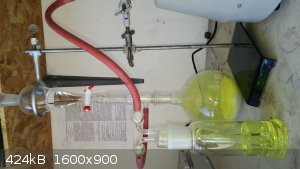 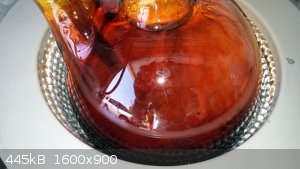 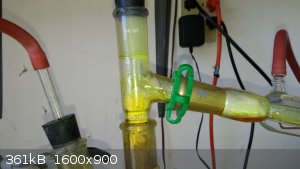 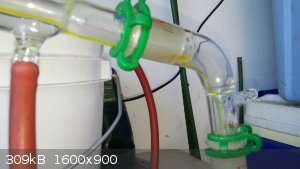 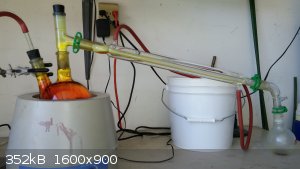 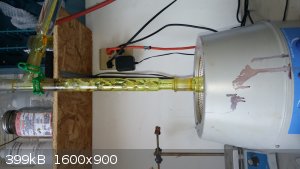 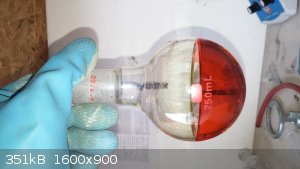 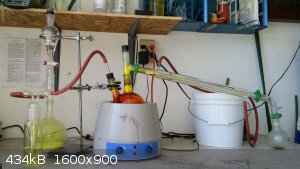
[Edited on 5-19-2015 by Polverone]
|
|
|
Tdep
National Hazard
   
Posts: 516
Registered: 31-1-2013
Location: Laser broken since Feb 2020 lol
Member Is Offline
Mood: PhD is done! It isn't good but it's over lol
|
|
Lovely! Cool setup. Definitely a compound that's nicer to look at pictures of rather than play with in person... Nah who am I kidding I need to make
some.
How did those rubber stoppers hold up? And it looks like this was done inside, was fumes/smell a significant issue?
|
|
|
Magpie
lab constructor
    
Posts: 5939
Registered: 1-11-2003
Location: USA
Member Is Offline
Mood: Chemistry: the subtle science.
|
|
Nice!
Looking at your separatory funnel sitting in that iron ring makes me squirm. I would suggest that you place some rubber tubing on the ring to protect
the glass.
Are you going to gas your product with Cl2 to form SCl2 as the next step?
The single most important condition for a successful synthesis is good mixing - Nicodem
|
|
|
j_sum1
Administrator
       
Posts: 6218
Registered: 4-10-2014
Location: Unmoved
Member Is Offline
Mood: Organised
|
|
Not too dissimilar to what aga has been doing lately. Lovely pix.
Looking forward to getting my glassware so that I can have a try.
|
|
|
aga
Forum Drunkard
    
Posts: 7030
Registered: 25-3-2014
Member Is Offline
|
|
Looks like a much more professional setup than my attempt !
What smell do you get off the product ?
I didn't distill mine.
The colour is the same, yet i expect yours to smell slightly less 'orrible.
[Edited on 15-5-2015 by aga]
|
|
|
DJF90
International Hazard
    
Posts: 2266
Registered: 15-12-2007
Location: At the bench
Member Is Offline
Mood: No Mood
|
|
I don't think you have pure disulfur dichloride as your product is significantly red:
http://www.sciencemadness.org/talk/viewthread.php?tid=10363
Notice how Klute's product (when sufficiently purified) is golden yellow in colour, matching the physical description given in texts like Armarego and
Perrin. I'd set up for a brief reflux over some sulfur, and then distil.
|
|
|
CuReUS
National Hazard
   
Posts: 928
Registered: 9-9-2014
Member Is Offline
Mood: No Mood
|
|
| Quote: | | The S2Cl2 made here will be used in the preparation of Thionyl Chloride which I would be happy to post on a SOCl2 related page.
|
why bother to make SOCl2 when you have S2Cl2.it can be used for most,if not all the reactions of thionyl chloride
|
|
|
aga
Forum Drunkard
    
Posts: 7030
Registered: 25-3-2014
Member Is Offline
|
|
Mine will be a mix of mono and dichloride with dissolved sulphur & chlorine i guess.
Yes, it does have a red-ish hue.
I should distill it just to see the true colour.
|
|
|
blogfast25
International Hazard
    
Posts: 10562
Registered: 3-2-2008
Location: Neverland
Member Is Offline
Mood: No Mood
|
|
But you analysed yours to be 100 % S<sub>2</sub>Cl<sub>2</sub>, did you not?
|
|
|
Magpie
lab constructor
    
Posts: 5939
Registered: 1-11-2003
Location: USA
Member Is Offline
Mood: Chemistry: the subtle science.
|
|
But if his end target is SOCl2 (thionyl chloride) why not just gas the present product with Cl2, then purify the SCl2?
The single most important condition for a successful synthesis is good mixing - Nicodem
|
|
|
DJF90
International Hazard
    
Posts: 2266
Registered: 15-12-2007
Location: At the bench
Member Is Offline
Mood: No Mood
|
|
Quote: Originally posted by Magpie  |
But if his end target is SOCl2 (thionyl chloride) why not just gas the present product with Cl2, then purify the SCl2? |
Sorry Magpie, I must have missed the intended use. In that case, it makes no sense as to why such a laborious purification was performed; catalytic
iron could have been added and gassing continued, followed by distillation to obtain the sulfur dichloride directly.
|
|
|
itsmetheuglykid
Harmless

Posts: 15
Registered: 25-11-2014
Member Is Offline
Mood: No Mood
|
|
DJF90- that was my original concern when seeing the color. What I forgot to mention was that during the fractional distilation, I added a considerable
amount of sulfur but the color remained red. Perhaps I will heed your advice and reflux w/ sulfur, distill, and report back.
The hoses held up just fine. The rubber stopper became brittle but remained in tact. My set up is right next to the garage door which I leave wide
open with a fan if the fumes become a problem; but I usually wear a respirator just to be safe.
Magpie...that is a good idea, I will do that. Thank you. And yes I plan to gas this with Cl2 in an oil bath above the boiling point of SCl2 but below
S2Cl2...say 120C. The SCl2 vapors that continuously form will combine with SO2 & excess chlorine over a hot activated charcoal bed in making
SOCl2. Which will then be purified and used in the making of alkyl chlorides.
aga, I was trying to find your post but no joy. Can you post the link?
|
|
|
CuReUS
National Hazard
   
Posts: 928
Registered: 9-9-2014
Member Is Offline
Mood: No Mood
|
|
| Quote: | | And yes I plan to gas this with Cl2 in an oil bath above the boiling point of SCl2 but below S2Cl2...say 120C. The SCl2 vapors that continuously form
will combine with SO2 & excess chlorine over a hot activated charcoal bed in making SOCl2. Which will then be purified and used in the making of
alkyl chlorides. |
I think you didn't read my post,S2Cl2 can make alkyl halides from alcohols,you don't need to convert it to thionyl chloride
|
|
|
aga
Forum Drunkard
    
Posts: 7030
Registered: 25-3-2014
Member Is Offline
|
|
http://www.sciencemadness.org/talk/viewthread.php?tid=62254
Yes. Distilling it won't hurt though (i hope !).
|
|
|
itsmetheuglykid
Harmless

Posts: 15
Registered: 25-11-2014
Member Is Offline
Mood: No Mood
|
|
CaReUS...I'm sorry I don't know how I overlooked it. That is interesting! Do you have access to any literature on the subject that you could send me?
I had no such luck in my endeavor. It would be very lovely if I could abandon my next step. Thionyl chloride seemed favorable because the byproducts
are gaseous, but I wont complain if I can avoid having to make it.
I am, however, familiar with sulfur dichloride oxide (SOCl2), sulfuryl chloride (SO2Cl2), Carbon Tetrachloride (CCl4) + PPh3, phophorus pentachloride
(PCl5), phosphorus trichloride (PCl3), the Lucus Reagent Zinc Chloride(ZnCl2) + HCl, and acetyl chloride and ethanol as alternative chlorinating
agents. I feel like I read something in the past about a substitute for thionyl chloride, but after perusing for some time I could not find anything
that looked familiar.
aga... Interesting! I really like the way you did yours! No nasty mess to clean up afterwards. Did you build your own fume hood? If so, would you mind
posting a picture of it? I was thinking about building my own. I do not like having to keep the garage door open during my experiments; for the simple
fact that my neighbors might misconstrue my interest in chemistry for illegal activities.
[Edited on 16-5-2015 by itsmetheuglykid]
|
|
|
Magpie
lab constructor
    
Posts: 5939
Registered: 1-11-2003
Location: USA
Member Is Offline
Mood: Chemistry: the subtle science.
|
|
Quote: Originally posted by itsmetheuglykid  |
Magpie...that is a good idea, I will do that. Thank you. And yes I plan to gas this with Cl2 in an oil bath above the boiling point of SCl2 but below
S2Cl2...say 120C. The SCl2 vapors that continuously form will combine with SO2 & excess chlorine over a hot activated charcoal bed in making
SOCl2....
|
I have not researched the making of SOCl2 but I was under the impression that SO3 is reacted with SCl2 to make thionyl chloride. That is the method
that Len1 used and is presented in his book. Is your method with charcoal an alternate route?
Quote: Originally posted by itsmetheuglykid  | CaReUS...I'm sorry I don't know how I overlooked it. That is interesting! Do you have access to any literature on the subject that you could send me?
I had no such luck in my endeavor. It would be very lovely if I could abandon my next step. Thionyl chloride seemed favorable because the byproducts
are gaseous, but I wont complain if I can avoid having to make it.
|
I think that a facile and safe method for making thionyl chloride is a worthy pursuit in its own right. It is a very useful reagent.
Quote: Originally posted by itsmetheuglykid  |
... I do not like having to keep the garage door open during my experiments; for the simple fact that my neighbors might misconstrue my interest in
chemistry for illegal activities.
|
You must live in an alternate universe than mine. How come the DEA hasn't been called? See the thread posted above:
http://www.sciencemadness.org/talk/viewthread.php?tid=62410
[Edited on 16-5-2015 by Magpie]
The single most important condition for a successful synthesis is good mixing - Nicodem
|
|
|
aga
Forum Drunkard
    
Posts: 7030
Registered: 25-3-2014
Member Is Offline
|
|
My first ever SM post :-
http://www.sciencemadness.org/talk/viewthread.php?tid=29710
It is basically a dexion-type shelving unit (€10 from IKEA) with some glass sheets siliconed to it to make a tray at the bottom.
The 'top' or 'roof' is a metal shelf. The back and sides are hardboard.
It's nowhere as clean as in the original photos, and i upgraded the fan as people suggested.
Today it is basically the same structure and still works fine, although has mutated somewhat over it's working life.
Edit: I just posted photos of how it looks now 
[Edited on 16-5-2015 by aga]
|
|
|
itsmetheuglykid
Harmless

Posts: 15
Registered: 25-11-2014
Member Is Offline
Mood: No Mood
|
|
| Quote: |
I have not researched the making of SOCl2 but I was under the impression that SO3 is reacted with SCl2 to make thionyl chloride. That is the method
that Len1 used and is presented in his book. Is your method with charcoal an alternate route?
|
There are 3 methods that I am aware of. SCl2+SO3->SOCl2+SO2 what you mentioned. SO2Cl2+SCl2->2SOCl2...SO2Cl2 by 2SCl2+O2, &
SCl2+Cl2+SO2->2SOCl2 which is the route that I chose. I attached a paper that covers that method if your interested. I prefer to not work with SO3
if I don't have to. And after reading that post I will no longer be leaving my garage door open!! Aga thats pretty rad. Time to get started on my I
suppose.
Attachment: thionyl chloride 2.pdf (707kB)
This file has been downloaded 446 times
|
|
|
Chemosynthesis
International Hazard
    
Posts: 1071
Registered: 26-9-2013
Member Is Offline
Mood: No Mood
|
|
I recommend investing in some more clamps.
Especially given his first few post topics. You would have thought NSA and
DEA SOD would freak out.
|
|
|
itsmetheuglykid
Harmless

Posts: 15
Registered: 25-11-2014
Member Is Offline
Mood: No Mood
|
|
Ya the clamps are on there way.
[Edited on 18-5-2015 by itsmetheuglykid]
|
|
|
AJKOER
Radically Dubious
    
Posts: 3026
Registered: 7-5-2011
Member Is Offline
Mood: No Mood
|
|
OK, some nice glassware. However, given the potential cleaning issues associated with this reaction, may I dare suggest an unconventional and simple
procedure. Per this reference https://books.google.com/books?id=1cyWgXMfe6QC&pg=PT107&... apparently Sulfur not only burns in O2, but once ignited S continues to burn in
Cl2 gas, with the formation of a reddish (also described as orange yellow) liquid, which I take to be a combination of yellow S2Cl2 and red (or cherry
red) SCl2 per the reactions:
S8 + 4 Cl2 → 4 S2Cl2
S2Cl2 + Cl2 ↔ 2 SCl2
The use of dry chlorine is best as one wishes to avoid any of the reactions:
Cl2 + H2O = HCl + HOCl
S8 + 16 HOCl → 16 HCl + 8 SO2
2 S2Cl2 + 2 H2O → SO2 + 4 HCl + 3/8 S8, etc.
Atomistry makes the following interesting comments on S2Cl2, to quote:
"Sulphur monochloride will not burn under ordinary conditions in the air, but when passed through a red-hot tube in the vapour condition and mixed
with air or oxygen, combustion occurs, accompanied by a greenish-blue flame and the formation of sulphur dioxide and trioxide, together with chlorine.
In contact with water the monochloride undergoes decomposition according to the equation:
S2Cl2 + 2H2O = H2S + 2HCl + SO2.
Even in the presence of a large excess of water decomposition only proceeds to the extent of 93.68 per cent., being partly restrained by the presence
of the hydrogen chloride formed. The other factor which influences the extent of the action is the sulphur formed by subsequent reaction between the
hydrogen sulphide and the sulphur dioxide. Polythionic acids are formed in solution and the sulphur which separates encloses undecomposed chloride and
may also dissolve in it. "
Note the formation of H2S in the above reaction of which I recall reports.
I would actually try to target the formation of more SCl2 than S2Cl2 by burning, in an excess of dry chlorine, a thin layer of sulfur spread over a
wide area. Cool the sides of the reaction chamber (which one may elect to cover with plastic wrap to limit cleanup issues). Collected the product and
distill over elemental sulfur to obtain pure disulfur dichloride. The details of this procedure are given in Atomistry to quote:
"The monochloride may be obtained in a highly purified condition by mixing a high-grade commercial sample with 1 per cent, by weight of a mixture of
highly absorbent charcoal and sulphur, distilling in glass apparatus and collecting the fraction distilling above 137° C. This fraction, after
addition of more charcoal and sulphur, is redistilled in a vacuum under a pressure of 28 mm., pure sulphur monochloride -distilling at 41° C."
Possible embodiments of the burning sulfur path would be simple, for example, place a plate or metal lid containing burning sulfur in a large vessel
of dry chlorine gas.
-----------------------------------------
With respect to SOCl2, I suspect that the following reaction is viable:
SCl2 + SO2 + Cl20 → SOCl2 + SO2 + Cl2
Or, SCl2 + Cl20 --SO2--→ SOCl2 + Cl2
as it is clearly a takeoff of the better known reaction:
SCl2 + SO3 → SOCl2 + SO2
which is described as occurring by the action of sulphur trioxide on sulphur dichloride at 75 -80° C. (Journ. Chem. Soc., 1903, p. 420). The related
cited path by the direct action of Cl2O on sulfur at low temperature, I believe is too violent, which results in the formation of SO2, I suspect, at
least as an intermediary (as aqueous HOCl can act on sulfur to form SO2/H2SO3).
Now as:
Ca(ClO)2 + CO2 → CaCO3 + Cl2O ( reference: http://en.m.wikipedia.org/wiki/Cl2O#/search )
Upon substituting SO2 for CO2, most likely also:
Ca(ClO)2 + SO2 → CaSO3 + Cl2O
which implies that may be able to form SOCl2 by passing a large amount of SO2 over calcium hypochlorite and into SCl2. The latter can be prepared per
Atomistry http://sulphur.atomistry.com/sulphur_dichloride.html to quote:
"An equilibrium mixture of composition corresponding to SCl2 is most easily prepared by allowing a solution of sulphur monochloride in liquid chlorine
to warm to the ordinary temperature; a modification of this process is to saturate the monochloride, cooled in a freezing mixture, with chlorine and
subsequently remove excess of the latter gas by a stream of carbon dioxide. Powdered absorbent charcoal acts catalytically in facilitating the action.
As prepared in this way, the mixture is a deep, reddish-brown liquid, of density 1.622 at 15° C. It boils at 59° C. under atmospheric pressure, and
at -24° C. under 4 mm., but on account of the very considerable dissociation into monochloride and chlorine, the boiling-point is not constant. When
cooled, it solidifies near -88° C. and remelts at -78° C. "
An old thread http://www.sciencemadness.org/talk/viewthread.php?tid=23634#... , or at least the report of what was observed, gives some hope as to the possible
success of this path to SOCl2 as to quote:
Quote: Originally posted by Oscilllator  |
A small amount of sulfur (from a gardening store) and Calcium hypochlorite (as pool chlorine) was mixed together then put in a test tube. The test
tube was heated with an alchohol burner and almost immediately an orange colour was observed. The mixture in the test tube then proceeded to boil and
release a moderate amount of stinky white gas that was so dense it was pourable.
This continued until all of the mixture was splotchy orange and white. The orange substance appeared to be some sort of liquid, but it solidified as
the test tube cooled.
After it was cool, There was a small amount of sulfur deposited on the walls of the test tube, and when water was poured into the test tube, an
exothermic reaction proceeded with the evolution of more of the white gas.
Anyway, does anyone know what this reaction produces? I think there might be some sulfur chlorides going on here, but thats just a suspicion. It could
also be that the white gas observed during the reaction was water hanging around in the reagents. |
Note, I am not recommending heating sulfur and the hypochlorite in any form of a closed vessel as an explosion is likely.
-------------------------------------------------
A possibly easier path is, per above extract from Atomistry, would be to just pass S2Cl2 through a red-hot tube in the vapour condition, mixed with
air or oxygen, upon which combustion occurs (a greenish-blue flame) with the formation of sulphur dioxide and trioxide, together with chlorine. Then,
pass the latter into SCl2 to form SOCl2.
[Edited on 19-5-2015 by AJKOER]
|
|
|
Magpie
lab constructor
    
Posts: 5939
Registered: 1-11-2003
Location: USA
Member Is Offline
Mood: Chemistry: the subtle science.
|
|
Thank you for the link to the patent. I don't blame you for not wanting to prepare and use SO3. But at least with that method you only have to
control 2 reactants. Looking at Len1's procedure I would guess that temperature control is much easier. Whereas with your method you must control the
continuous addition of 3 reactants plus maintain temperature within range. It would be good if you had a helper when doing this. Also, with all
those sulfur species you may release some potent smells at the outlet of your hood. Not only should you keep your garage door closed but it would be
advantageous to (1) wait for a good wind, and (2) wait for the neighbors to go on vacation.
The patent is well written, has good sketches and plenty of experimental data. Also it was written back when patents were usually believable.
I wish you the best of luck, and please report your results to the forum.
[Edited on 19-5-2015 by Magpie]
The single most important condition for a successful synthesis is good mixing - Nicodem
|
|
|
| Pages:
1
2
3 |